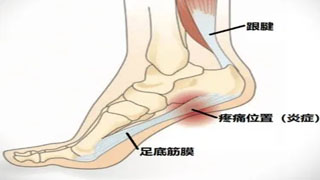
Plantar fasciitis is a disease that can cause pain and discomfort in the heel. The plantar fascia is a tissue band that extends from the heel to the toes along the sole of the foot. When the tissue becomes inflamed or inflamed, it can cause pain in the heel or arch of the foot.
However, with appropriate treatment, you can control plantar fasciitis and restore normal activity with less pain. This article will provide tips for safe running when suffering from plantar fasciitis.
Some common symptoms of plantar fasciitis include:
Pain at the bottom of the heel.
The pain will intensify when taking the first step in the morning.
Long term walking, sitting, or lying down can cause discomfort and pain.
The pain persists for several months.
My heel is swollen
Reduced ankle range of motion and tightened calf muscles
The causes of plantar fasciitis pain
Different factors can cause plantar fasciitis pain. One of the most common reasons is overuse. If you are a runner who frequently runs long distances, you may be more susceptible to plantar fasciitis. Other risk factors include:
Flat feet with lower arches
Obesity
Having tight calf muscles and a high arch
Exercise regularly on hard floors.
Do not stretch the calves during exercise
Standing for a long time.
Is it safe to run with plantar fasciitis?
Running with plantar fasciitis is safe and can be done in moderation. However, it is important to remember that running - even just walking - can exacerbate symptoms of plantar fasciitis.
If you suffer from plantar fasciitis, you should avoid jumping or sprinting, which can increase the tension of the arch and further stimulate the plantar fascia. The best running method for patients with plantar fasciitis is to use heel pads or insoles to reduce foot pressure and provide additional support.
You should also keep your stride short and fast, not long and slow. This will reduce the energy transmitted through the legs to the feet, which helps prevent further damage to the arch of the foot, while also reducing pain and inflammation.
10 suggestions for runners with plantar fasciitis
Adjusting lifestyle and following specific tips can help alleviate the pain of runners with plantar fasciitis.
1. Do not wear shoes without support
If you have flat feet and a lower arch, you are more likely to become a victim of plantar fasciitis because the pressure on the arch can cause pressure on the plantar fascia. Over time, this condition can lead to chronic inflammation of the plantar fascia.
However, if you want to run without feeling too much pain, you must wear suitable and comfortable shoes. Wearing shoes with arch support will help you maintain the correct alignment of joints, feet, ankles, and connective tissue muscles.
2. Warm up before running
Warm up activities must be performed before any exercise. For patients with plantar fasciitis, warming up before running can improve blood circulation, reduce joint stiffness and muscle tension, thereby reducing foot pressure.
To warm up your body before exercising, you can engage in various exercises to help activate muscles, such as heel raising, ankle rotation, squats, lunges, and leg swings.
3. Conduct cross training
Plantar fasciitis is a painful injury that can prevent runners from participating in races, so it is important to understand the best way to treat it. Good news: Cross training can help alleviate the effects of plantar fasciitis and even prevent it in some cases.
You can start with walking or doing light training, or engage in more intense training, including using weight or simulated running machines. In addition, it also helps to maintain muscle strength and flexibility, so that they do not become tense due to constant impacts while running.
4. Do you do stretching exercises every day for plantar fasciitis
Plantar fasciitis is a painful disease caused by incorrect foot posture. To prevent this from happening, please do stretching exercises every day. You should start by warming up and then walk to increase blood flow in your feet.
Afterwards, you can perform a set of calf or heel lifts. You can also perform other stretching exercises that require the use of toes and heels. You can use foot and leg stretchers to help alleviate the pain of plantar fasciitis.
5. Carefully massage the feet
Proper foot massage can help reduce stress and relieve pain. All you need to do is lie down and massage in a clockwise direction. Starting from the toes, all the way to the instep.
Use an upward movement, starting from the toes and moving towards the ankle bone, until reaching below the intersection of the calf and thigh muscles. This will make you feel good. Don't forget those calves - they should also receive some soothing massage.
6. Avoid running on uneven surfaces
Avoid running on uneven or hard surfaces. It requires your foot and ankle muscles to apply more force to stabilize your joints. In addition, it can also damage the plantar fascia, making it difficult for you to run.
You can go to the nearest jogging track to prevent foot injuries from running on rough ground.
7. Wipe ice cubes every day
Applying ice to the affected area can help runners with plantar fasciitis alleviate pain, inflammation, and swelling. This simple and easy technique is to use a bag filled with crushed ice and wrap it with a towel. The runner sits on the massage bed, placing one foot on the massage bed and placing an ice pack on the arch pain point.
After 20 to 30 minutes, they take out the bag, massage the area for another 10 seconds, and then take it out again. Runners should repeat this process three times a day because it is very effective.
8. Rest
Running frequently without allowing the body to rest can damage the arch of the foot. Resting between and after running will help your body recover and prevent plantar fasciitis.
9. Solve foot pain
Several types of foot pain may reduce your ability to apply pressure to your feet and cause trouble while running or walking.
However, it is best to consult your physical therapist or podiatrist to diagnose the root cause of foot pain and receive appropriate treatment.
10. Use kinematic adhesive tape
Applying two pieces of motion tape on your feet and ankles can help you achieve better foot alignment, reducing pain during running or walking and supporting your arch. You can apply the first piece of tape from the sole of your foot to near your heel.
You can also apply the second piece to the outer edge of the foot and push it horizontally onto the arch of the foot. The first piece of tape will provide stretch and keep the foot in your position, while the second piece of tape will support your arch.
When should I go see a doctor
If the pain persists for more than two weeks, please see a medical specialist. To alleviate symptoms, doctors may recommend treatments including orthotics, foot patches, cortisone injections, night splints, and anti-inflammatory drugs.
If the situation is severe, doctors may use physical therapy or shock wave therapy. However, if the situation does not improve, your doctor may turn to platelet rich plasma (PRP), which draws blood from your arm, rotates it, removes platelets, and then injects them into the fascia.
For those who still experience symptoms even after treatment, doctors may recommend surgery. This is mainly the last option, and before choosing surgery, your doctor needs to consider your overall health condition.
frequently asked questions
1. How do runners deal with plantar fasciitis?
Most of the time, they put their feet in the ice bucket. Then, massage the feet with a golf ball. It helps alleviate the pain caused by plantar fasciitis.
How to quickly cure plantar fasciitis?
Use cloth covered ice packs to alleviate discomfort. Extend the arch of the foot. Simple home exercises can stretch the plantar fascia, Achilles tendon, and calf.
What causes plantar fasciitis?
Plantar fasciitis affects the sole of the foot, most commonly causing pain in the center and inner side of the heel. It is caused by damage to the plantar fascia, which is a sturdy tissue band that extends from the heel below the arch to the base of the toes.
conclusion
Plantar fasciitis is inflammation of the plantar fascia (sole), which may worsen due to running, walking, or standing for too long. However, practicing simple home remedies such as ice massage, rest, wearing comfortable shoes, and applying exercise tape can help alleviate symptoms. If the pain persists, please consult a doctor.


